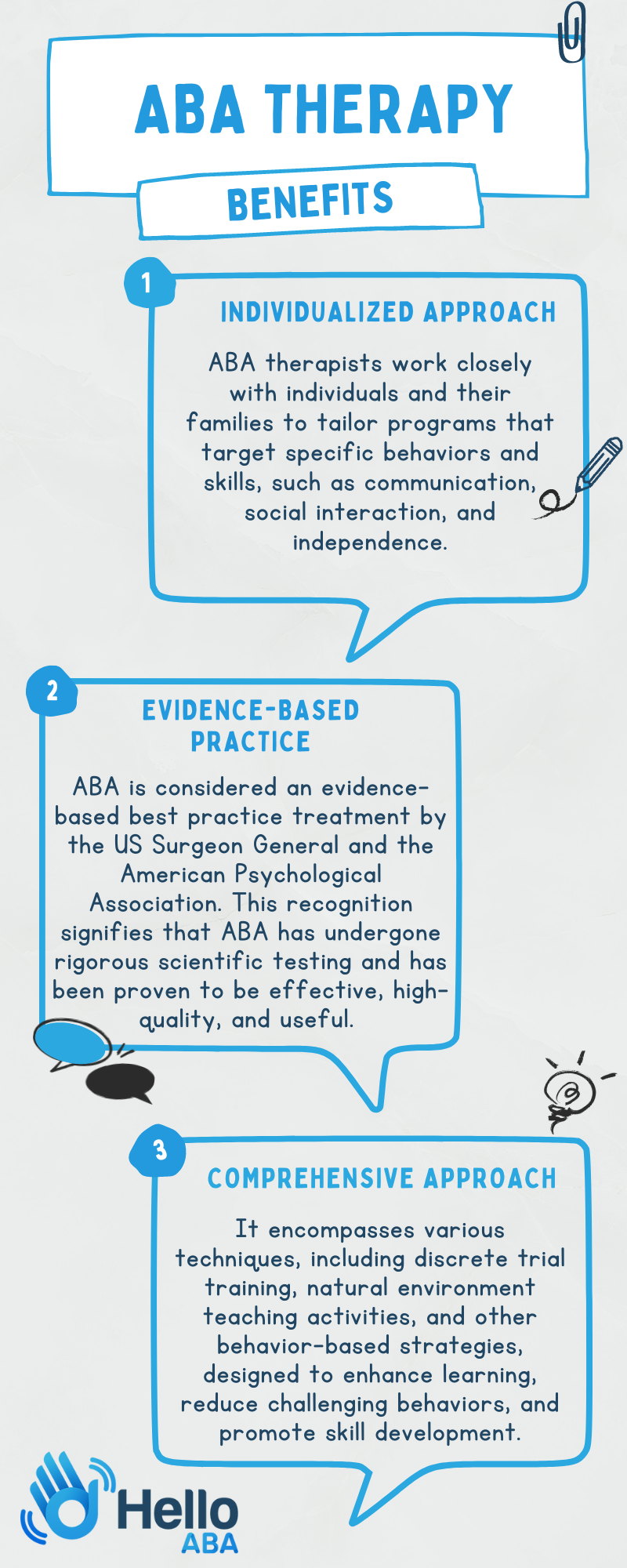ABA therapy, or Applied Behavior Analysis therapy, is a widely recognized and evidence-based approach used to support individuals with autism spectrum disorder (ASD). By understanding the principles and benefits of ABA, individuals, parents, and caregivers can gain insights into this effective therapy.
Principles of ABA Therapy
ABA is founded on the principles of behaviorism, which focus on understanding how learning occurs and how behavior is influenced by one’s environment. The principles of ABA therapy include:
1. Positive Reinforcement
ABA therapy commonly uses positive reinforcement as a primary strategy, particularly in supporting individuals with autism. Positive reinforcement involves providing rewards or incentives to encourage and strengthen desired behaviors. This approach has shown positive outcomes in
2. Prompting and Prompt Fading
ABA utilizes prompts to assist individuals in learning new skills or behaviors. Prompts can be verbal, physical, or visual cues that guide individuals towards the desired response. As the individual becomes more proficient, prompts are gradually faded, allowing them to independently perform the desired behavior.
3. Generalization
ABA aims to generalize skills across different environments and situations. This means helping individuals apply learned skills in various settings, such as home, school, or community. Generalization ensures that the skills acquired through ABA therapy are transferable and have practical utility in everyday life.
Benefits of ABA Therapy
ABA therapy has been extensively studied and proven effective for many individuals with autism. More than 20 studies have demonstrated that intensive and long-term therapy using ABA principles can lead to improvements in intellectual functioning, language development, daily living skills, and social functioning.
The benefits of ABA therapy include:

ABA therapy’s effectiveness extends beyond autism and is also used to treat other cognitive and developmental conditions, such as obsessive-compulsive disorder (OCD) and even dementia.
Understanding the principles and benefits of ABA therapy allows individuals and caregivers to make informed decisions about the most suitable interventions for those with autism. The customizable nature of ABA programs enables individuals to work towards achieving their behavioral goals, fostering growth, and improving overall quality of life.
Evidence-Based Support for ABA
ABA therapy, also known as applied behavior analysis therapy, is backed by strong evidence demonstrating its effectiveness in improving outcomes for individuals with autism. This section will explore the research studies conducted on ABA and its recognition by authoritative bodies.
ABA is considered an evidence-based best practice treatment by both the US Surgeon General and the American Psychological Association. This recognition signifies that ABA has passed scientific tests of its usefulness, quality, and effectiveness. The American Psychological Association recognizes ABA as an evidence-based practice treatment, indicating that it has undergone specific tests that analyze its effectiveness.
Furthermore, ABA treatments, such as Early Intensive Behavioral Intervention (EIBI), are widely regarded as effective and are consistently supported by independent reviews. Positive results of ABA and EIBI have been replicated in many studies, contributing to their recognition as evidence-based interventions for individuals with autism.
The recognition and support of ABA therapy by authoritative bodies reinforce its credibility and provide assurance to parents, caregivers, and individuals with autism that ABA is a valuable and evidence-based approach to improving the lives of those affected by autism.
The extensive research studies conducted on ABA therapy and its recognition by authoritative bodies validate its effectiveness and establish it as an evidence-based treatment for individuals with autism. The positive outcomes observed in various areas of development and the consistent replication of results highlight the value of ABA therapy in improving the lives of individuals with autism.
ABA Therapy Process
Understanding the ABA therapy process is essential. This section will explore the roles of therapists and the importance of customized programs in ABA therapy.
Therapist Roles
ABA therapy programs involve therapists, also known as Registered Behavior Technicians (RBTs), who work directly with individuals with autism. These therapists are trained and supervised by Board-Certified Behavior Analysts (BCBAs). Under the guidance of BCBAs, therapists play a crucial role in implementing ABA techniques and strategies to help individuals with autism develop and improve their skills.
RBTs work closely with individuals with autism to practice skills and work towards individualized goals set by the BCBA. They provide direct one-on-one therapy, implementing behavior intervention plans, teaching new skills, and collecting data to assess progress. The therapist’s role is to create a supportive and engaging environment that encourages learning and growth.
Customized Programs
A qualified and trained behavior analyst, known as a BCBA, plays a central role in ABA therapy. The BCBA designs and directly oversees ABA programs, customizing them to the unique needs of each learner. Before developing the program, the BCBA conducts a detailed assessment to understand the individual’s strengths, challenges, and specific areas that need improvement.
Based on the assessment, the BCBA writes specific treatment goals tailored to the individual’s age, ability level, and areas of focus. These goals serve as the foundation of the ABA therapy program and guide the therapist in delivering targeted interventions.
Customized programs in ABA therapy are crucial as they take into account the individual’s skills, needs, interests, preferences, and family situation. By personalizing the therapy program, ABA professionals can address the specific challenges and goals of each individual. This individualized approach enhances the effectiveness of the therapy and maximizes the potential for positive outcomes.
ABA therapy programs can be tailored to assist individuals in achieving their behavioral goals. This may include improving communication skills, social skills, and learning new behaviors. Therapists use a variety of strategies, techniques, and reinforcement strategies to teach and reinforce desired behaviors. The customization of the program ensures that the therapy plan is tailored to the unique needs of each individual.
Recognizing the importance of customization in ABA therapy ensures that professionals design the therapy to meet the specific needs of the individual. This personalized approach allows for greater success in achieving therapy goals and promotes positive outcomes.

Effectiveness of ABA Programs
Treating autism with ABA therapy has been recognized as an effective and evidence-based approach. Let’s explore two key aspects that contribute to the effectiveness of ABA programs: Early Intensive Behavioral Intervention and the positive outcomes associated with ABA therapy.
Early Intensive Behavioral Intervention
Early Intensive Behavioral Intervention (EIBI) is a type of ABA therapy that focuses on providing intensive and comprehensive treatment to young children with autism. More than 20 studies have established that intensive and long-term therapy using ABA principles, such as EIBI, leads to significant improvements in various areas of development.
Research consistently shows that EIBI can result in gains in intellectual functioning, language development, daily living skills, and social functioning. By implementing individualized treatment plans tailored to each child’s needs, EIBI aims to address specific challenges and promote overall development during the critical early years. The goal is to provide intensive support and intervention to maximize a child’s potential for positive outcomes.
Positive Outcomes
It’s important to note that ABA therapy is not limited to children; studies with adults utilizing ABA principles have also shown similar benefits. However, it’s worth mentioning that more research is needed to expand our understanding of ABA’s effectiveness in adult populations.
ABA therapy, including Early Intensive Behavioral Intervention, has consistently demonstrated positive outcomes in children with autism. The evidence-based nature of ABA therapy, recognized by authoritative bodies, strengthens its credibility and supports its use as a valuable treatment approach. By implementing ABA principles and individualized treatment plans, individuals with autism can experience improved development and enhanced quality of life.
Evaluation of ABA Interventions
Single Subject Experimental Designs
SSEDs play a crucial role in evaluating the evidence for ABA interventions. These designs involve conducting repeated observations to compare an individual’s behavior during baseline (prior to intervention) and intervention phases. By systematically measuring and analyzing behavior, researchers can determine whether introducing an intervention reliably leads to a change in behavior.
While some reviewers may choose to exclude SSED studies, they provide a powerful test of the impact of specific interventions on individuals. These designs allow for the evaluation of outcomes at an individual level, providing valuable insights into the effectiveness of ABA interventions for specific behaviors and individuals.
Comprehensive Treatment Models

ABA's Impact Across Fields
Applied Behavior Analysis (ABA) has had a significant impact across various fields, revolutionizing the way professionals approach behavior and learning. Let’s explore the history of ABA and its application in various disciplines.
History of ABA
ABA emerged as a field dedicated to understanding how behavior is influenced by the environment and how learning occurs. It has since become a widely recognized approach in a range of disciplines, including education, developmental disabilities, autism, clinical psychology, behavioral medicine, and organizational behavior management.
The foundation of ABA lies in its evidence-based nature. It emphasizes the use of scientific methods to analyze behavior and develop effective interventions. ABA practitioners strive to bridge the gap between research and practice, ensuring that interventions are grounded in empirical evidence and tailored to individual needs.
Application in Various Disciplines
The application of ABA extends beyond the field of autism. It has been successfully employed in diverse areas, enhancing the understanding of behavior and its impact on individuals’ lives. Some notable applications of ABA include:
- Education: ABA principles and strategies have been integrated into educational settings to promote effective teaching and learning. Educators utilize ABA techniques to shape behavior, improve academic performance, and facilitate skill development.
- Developmental Disabilities: ABA has demonstrated effectiveness in supporting individuals with developmental disabilities. It helps address challenging behaviors, promote functional skills, and enhance overall quality of life.
- Clinical Psychology: ABA plays a vital role in clinical psychology, particularly in the treatment of conditions such as obsessive-compulsive disorder (OCD) and other behavioral disorders. ABA techniques are used to identify the underlying causes of maladaptive behavior and develop interventions to address them.
- Behavioral Medicine: ABA has also made significant contributions to the field of behavioral medicine. It helps individuals make positive health behavior changes, such as adhering to medication regimens, managing chronic conditions, and adopting healthy lifestyle habits.
- Organizational Behavior Management: ABA principles are applied in organizational settings to improve employee performance, enhance workplace safety, and optimize productivity. By analyzing and modifying behavior, ABA interventions have proven effective in creating positive work environments.
As ABA continues to evolve and expand, its impact across fields continues to grow. The evidence-based nature of ABA has led to its recognition and adoption by various professions, aligning with the broader movement towards evidence-based practice (EBP) frameworks. This emphasis on empirical evidence and individualized interventions has contributed to the success and widespread acceptance of ABA in diverse disciplines.
ABA therapy encompasses a wealth of information and strategies aimed at understanding and modifying behavior. It is important to note that ABA is not a one-size-fits-all approach. Each intervention is tailored to the individual and takes into account their unique needs and circumstances. For those seeking ABA therapy in Maryland, Hello ABA offers personalized and evidence-based interventions. Contact us today to schedule a consultation or book an appointment.
Sources:
- https://www.autismspeaks.org/applied-behavior-analysis#:~:text=ABA%20is%20considered%20an%20evidence,by%20the%20American%20Psychological%20Association.
- https://www.necc.org/aba-an-evidence-based-treatment-for-autism/
- https://behavior.org/aba-evidence-based/
- https://www.ncbi.nlm.nih.gov/pmc/articles/PMC4883454/






